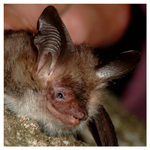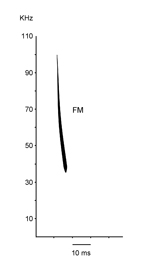Hálózáskor fogott nagyfülű denevér egyed.
Észak, Északnyugat Európán (Lengyelország északi része, Ukrajna, Skandináv félsziget) és egyes mediterrán vidékek kivételével mindenütt elterjedt. Románia területén is előfordul.
Általában erdőlakó faj, ritkán barlangokban is előfordul. Szülőkolóniái faodvakban találhatóak, ritkán épületekben. ezek egyedszáma nem haladja meg a pár tízet. Barlangokban, ritkábban faodvakban, magányosan hibernál. Vadászterületei bükkerdőkben, ligetes területeken találhatóak. Táplálékát ízeltlábúak, röpképtelen rovarok képezik. Helyhű faj, a legnagyobb megtett táv 73 km. A legmagasabb feljegyzett életkor 21 év.
Populációi veszélyeztetettek és csökkenő tendenciát mutatnak. Ez főképp helyhűségüknek és speciális élőhely igényeiknek tudható be, valamint ezen élőhelyek csökkenésének. Potenciális védelmi intézkedések lehetnek a szálláshelyek elszigetelésének megakadályozása (génáramlás biztosítása).
Barti L. (1999): A torjai Büdöshegy természetes gázömléseinek denevér-áldozatai (1997-1999). Acta Siculica, Aluta XXIII, Acta Hargitensia VI., 1: 103-114.
Barti L., Kovács I. (2001): A málnásfürdői mofetták gerinces áldozatainak jegyzéke (1999 febr. 28. - 2000 szept. 18). Acta Siculica, 1: 103-112.
Barti L. (2002d): A Daday Jenő által létrehozott denevérgyűjtemény a kolozsvári Állattani Múzeumban. Múzeumi Füzetek, 11: 67-72.[PDF]
Barti L., Varga Á. (2004): A torjai Büdöshegy gázasbarlangjainak, mofettáinak denevéráldozatai (1999-2002). Acta Siculica, 2003(1): 65-73.
Barti L., Varga Á. (2005): A torjai Büdöshegy gázasbarlangjainak, mofettáinak denevéráldozatai. Proceedings of the 2nd, 3rd. and 4th Conference of the Bat Conservation in Hungary, Magyar Denevérkutatók Baráti Köre, Budapest, p. 91-95.
Barti L., Dóczy A., Jére Cs., Varga Á. (2006): Rezultatele recensământului de lilieci în locurile de hibernare subterane în Sud-estul Transilvaniei. First Conference on Bat Conservation in Romania, Book of abstracts, Ed. Romanian Bat Protection Association, p.13.[PDF]
Barti L., Dóczy A., Jére Cs., Varga Á. (2007): Denevér-telelőhely ellenőrzések eredményei Délkelet-Erdélyben. Proceedings of the 5th Conference of the Bat Conservation in Hungary (Pécs, 3th to 4th of December 2005) and 6th Conference of the Bat Conservation in Hungary (Mártély, 12th to 14th of October 2007), Magyar Denevérkutatók Baráti Köre, Budapest, p. 51-62.[PDF]
Barti L., Jére Cs., Dóczy A., Szodoray-Parádi F. (2007): A Vargyas-szoros recens és szubfosszilis denevérfaunája és faunisztikai adatbázisa a kezdetektől 2007 februárjáig. Acta Siculica, p. 153-178.[PDF]
Bazilescu E. (1983): Consideraţii asupra faunei de mamifere din Oltenia şi propuneri pentru ocrotirea speciilor rare. Studii şi Cercetări, Drobeta Turnu-Severin, p. 195-199.[PDF]
Bielz E.A. (1886): Über die in Siebenbürgen vorkommenden Fledermäuse. Verhandlung und Mittheilungen des siebenbürgischen Vereins für Naturwissenschaften, Sibiu, 36: 76-84.[PDF]
Bielz E.A. (1888): Die Fauna der Wirbeltiere Siebenbürgens nach ihren gegenwärtigen und jetzigen Bestande. Verhandlung und Mittheilungen des siebenbürgischen Vereins für Naturwissenschaften, Sibiu, 38: 15-36.[PDF]
Borda D. (2002): Chiropterele. in: Racoviţă Gh., Moldovan O., Onac B. (ed.): Monografia carstului din Muntii Padurea Craiului, Studiu monografic. Presa Universitară, Cluj-Napoca, p. 172-182.[PDF]
Chachula O., Valenciuc N., Done A. (2008): Contributions to the study of Chiroptera from Moldavia (Romania). Analele Ştiinţifice ale Universităţii "Al. I. Cuza" Iaşi, ser. Biologie animală, 54: 237-244.[PDF]
Dumitrescu M., Samson P., Terzea E., Rădulescu C., Ghica M. (1962-1963a): Peştera "La Adam", staţiune pleistocenă. Lucrările Institutului de Speologie "Emil Racoviţă", Bucureşti, I-II: 229-285.
Dumitrescu M., Tanasachi J., Orghidan T. (1962-1963b): Răspândirea chiropterelor în R.P. Română. Travaux de l'Institut de Spéologie "Émile Racovitza", Bucureşti, XXXIV: 509-575.[PDF]
Ifrim I., Pocora V. (2006): Aspecte preliminare privind studiul chiropterelor din Pădurea Letea. First Conference on Bat Conservation in Romania. Book of Abstracts, Ed. Romanian Bat Protection Association, p. 6.[PDF]
Ifrim I., Pocora V. (2007b): Preliminary aspects about the study of bats from Letea Forest - Danube Delta. Scientific Annals of the Danube Delta Institute, 13: 27-34.[PDF]
Jére Cs., Dóczy A., Barti L. (2007): Results of research on the bat fauna of the Vârghiş Gorge (Eastern Carpathians, Romania). Travaux de l'Institut de Spéologie "Émile Racovitza", XLV-XLVI, p. 59-74. [PDF]
Kadič O. (1916): A herkulesfürdői Zoltán-barlang. Barlangkutatás, IV: 109-111.
Méhely L. (1912): A nagyfülű denevér előfordulása Szászkabányán. Természettudományi Közlöny, XLIV(559): 600. [PDF]
Murariu D. (2002): Contributions to the knowledge of mammal fauna (Mammalia) from south west Romania. Travaux du Muséum National d'Histoire Naturelle "Grigore Antipa", XLIV: 431-441.[PDF]
Murariu D. (2004): New reports on the distribution of three bat species (Mammalia: Chiroptera) of Romania. Travaux du Museum National d'Histoire Naturelle "Grigore Antipa", XLVI: 271-279.[PDF]
Nagy L.Z., Barti L., Dóczy A., Jére Cs., Postawa T., Szántó L., Szodoray-Parádi A., Szodoray-Parádi F. (2005): Survey of Romania's underground bat habitats Carpathian's underground bat habitats. Status and distribution of cave dwelling bats (2002-2004). Final report for the BP Conservation Programme. Survey of Southern and Western Carpathians underground bat habitats & Survey of Eastern Carpathians and Dobrogea underground bat habitats, Ed. Lizard, Cluj, pp. 44.[PDF]
Negrea A., Botoșăneanu L., Negrea Şt. (1967): Documents pour servir à la connaissance de la faune de mammifères des grottes du Banat (Roumanie). International Journal of Speleology, 2(4): 341-353.[PDF]
Szodoray-Parádi F., Szodoray-Parádi A. (2005): Results on the investigatin on bats fauna in Vânători Neamţ Natural Park and conservation status of the occurring bat species. Studies and research in Vânători Neamţ Natural Park, I: 93-98.[PDF]
Topál Gy. (1954): A Kárpát-medence denevéreinek elterjedési adatai. A Magyar Nemzeti Múzeum Természettudományi Osztályának Évkönyve, Budapest, 46: 471-483.[PDF]
Valenciuc N., Chachula O. (2001): Myotis bechsteini Kuhl şi Myotis nattereri Kuhl, specii noi pentru fauna chiropterelor din Moldova. Sesiunea de comunicări ştiinţifice "Ecosinteze şi etnosinteze carpatine", Nov. 2-3, 2001.[PDF]
Vremir M. (1998): Mica tragedie a liliecilor din Avenul Pobraz. Speomond, 3: 33.[PDF]
- Baagøe H. (2001): Myotis bechsteinii (Kuhl 1818) - Bechsteinfledermaus. Pp. 443-471. In: Krapp F. (ed.): Handbuch der Säugetiere Europas. Band 4: Fledertiere. Teil I: Chiroptera I. Rhinolophidae, Vespertilionidae 1. Aula-Verlag, Wiebelsheim.
- Dietz C., Helversen O., Nill D. (2007): Myotis bechsteinii. Handbuch der Fledermäuse Europas und Nordwestafrikas. Kosmos Verlag, Stuttgart. Pp. 247-251.
- Kerth G., Kiefer A., Trappmann C., Weishaar M. (2003): High gene diversity at swarming sites suggest hot spots for gene flow in the endangered Bechstein's bat. Conservation Genetics 4: 491-499.















